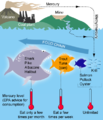Dosiero:MercuryFoodChain-01.png
Etoso

Grandeco de ĉi antaŭvido: 515 × 600 rastrumeroj. Aliaj distingivoj: 206 × 240 rastrumeroj | 625 × 728 rastrumeroj.
Bildo en pli alta difino ((625 × 728 rastrumeroj, grandeco de dosiero: 116 KB, MIME-tipo: image/png))
Dosierhistorio
Alklaku iun daton kaj horon por vidi kiel la dosiero tiam aspektis.
| Dato/Horo | Bildeto | Grandecoj | Uzanto | Komento | |
|---|---|---|---|---|---|
| nun | 01:31, 11 jul. 2011 |  | 625 × 728 (116 KB) | File Upload Bot (Magnus Manske) | {{BotMoveToCommons|en.wikipedia|year={{subst:CURRENTYEAR}}|month={{subst:CURRENTMONTHNAME}}|day={{subst:CURRENTDAY}}}} {{Information |Description={{en|This figure shows some common sources of mercury, the conversion to toxic methylmercury and the outline |
Dosiera uzado
La jena paĝo ligas al ĉi tiu dosiero:
Suma uzado de la dosiero
La jenaj aliaj vikioj utiligas ĉi tiun dosieron:
- Uzado en ar.wikipedia.org
- Uzado en en.wikipedia.org
- Uzado en es.wikipedia.org
- Uzado en fi.wikipedia.org
- Uzado en fr.wikipedia.org
- Uzado en it.wikipedia.org
- Uzado en ru.wikipedia.org
- Uzado en uk.wikipedia.org


